Spinal stenosis is a condition that can occur at any level of the spine. It is a condition that can cause pain in the neck, mid back or low back. This article will concentrate on spinal stenosis of the lumbar spine (low back). This is the most common area for stenosis to occur.
The symptoms of spinal stenosis are often like other conditions of the spine. However, the progression of the disease and treatment for stenosis are unique to this condition. It is important for those with spinal stenosis and sciatica symptoms to find the root cause. Additionally, there are times that spinal stenosis is not symptomatic at all.
In this article, I will try to help you recognize the common signs and symptoms of spinal stenosis and offer ways to manage the potential symptoms. Please see our other blog posts where we have addressed other common causes of sciatica.
What is Lumbar spinal stenosis?
Spinal stenosis is a narrowing of the canal in which the spinal cord runs from our brain stem in the neck area to the cauda equina in the lumbar spine. In an average adult, the spinal cord tapers and ends between the first and second lumbar vertebrae.
The most distal bulbous part of the spinal cord is called the conus medullaris, and its tapering end continues as the filum terminale. Between about the Lumbar 1 and Lumbar 2 spinal levels the spinal cord is separated into a collection of nerve roots, which are horse tail-like in appearance and hence called the cauda equina (Latin for horse’s tail). (See the image of anatomy below.)
The picture below shows a single vertebral segment from the top looking down. Imagine five of these stacked on top of each other in the lumbar spine.
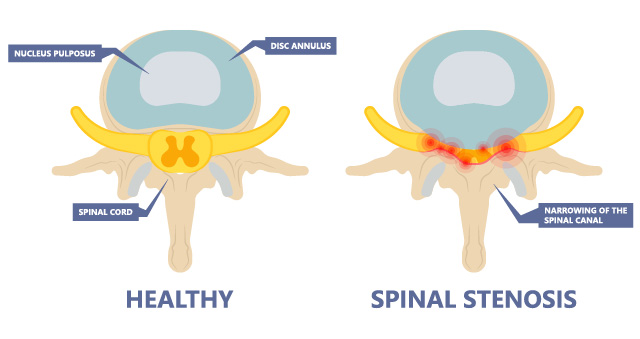
The image below shows a top view of 1 vertebral segment and a side view of 2 segments stacked on each other illustrating the orientation of the spinal cord and cauda equina (depending upon the level of the spine.
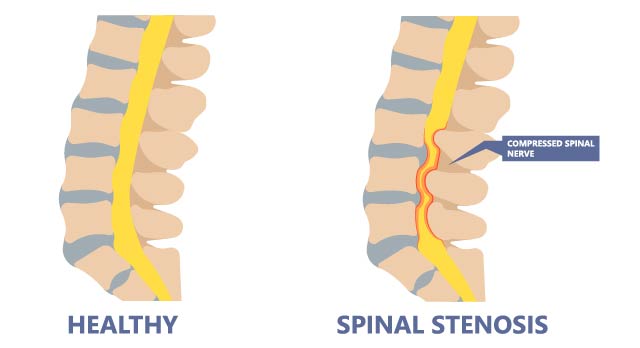
What Causes Spinal Stenosis?
There are many different potential causes for sciatica, including poor posture, bad sleeping habits, and more. In the case of stenosis the narrowing of the spinal canal can touch upon and irritate the nerve roots or spinal cord itself. This may cause several different symptoms including sciatica (pain into the buttocks, hamstrings and calf area).
Common spinal stenosis causes include:
- Wear and tear from osteoarthritis on your spinal bones, causing bone spurs.
- Injuries to the spine such as dislocations or fractures.
- Herniated disks
Potential symptoms of spinal stenosis
Common spinal stenosis symptoms include:
- Pain in the Spine
- Numbness
- Tingling
- Muscle Weakness
- Poor Coordination
- Difficulty Walking
- Pain and Cramping in the Legs especially with walking (pseudo claudication)
The prognosis (a forecast of the likely course) of spinal stenosis.
In most cases the prognosis for spinal stenosis is very good. Though this condition will not “heal” like other causes of sciatica. Many people can obtain good relief of their symptoms with nonsurgical treatment, by watching posture, maintaining ideal body weight and exercising for flexibility and strength.
In some cases, as the stenosis becomes more severe, the nonsurgical treatment becomes less effective as the ligaments thicken and joints begin to degenerate. For those patients, surgery is a good option to consider. In the most severe cases loss of bowel and bladder function may occur and this is considered a medical emergency.
How do you know you might have spinal stenosis?
The best method of determining if your sciatica is coming from spinal stenosis is seeing a qualified spine specialist who can rule out other causes. It is likely that your doctor may recommend an MRI or CT scan. Short of that there are ways to examine signs and symptoms to give you a better idea.
One model for clinical prediction, with moderate accuracy, was developed by a group of researchers and is often referred to as the Cook rule. If one meets at least four of the following criteria, it strongly suggests that lumbar spinal stenosis may be the cause:
- Bilateral lower extremity symptoms. Pain, numbness, weakness and or tingling in both lower extremities.
- Lower extremity pain more often and greater than back pain.
- Pain during walking or standing. (When you stand your back goes into extension or arched position, decreasing the space in the spinal canal.
- Pain relief upon sitting (when you sit your spine goes into flexion, increasing the space in the spinal canal.)
- If you are greater than 48 years old.
Keep in mind that any loss of bowel and bladder control, persistent, severe weakness (drop foot) or an inability to stand and walk that persists for more than a day or two requires the attention of a physician.
Spinal Stenosis Treatment Exercises and Stretches
While the best treatment for spinal stenosis likely includes a trip to a spinal specialist, here are some at-home suggestions for a DIY physical therapy plan. If you experience the criteria listed above and you have none of the signs or symptoms that requires seeing a physician there are ways to manage stenosis on your own.
Maintaining spinal mobility, flexibility and stability are important. Keeping you hips flexible and strong will be important and being diligent in maintain good posture during activities will help. Use the following exercises to relieve pain and reduce inflammation:
Spine flexibility/mobility
Supine opposite arm leg stretch
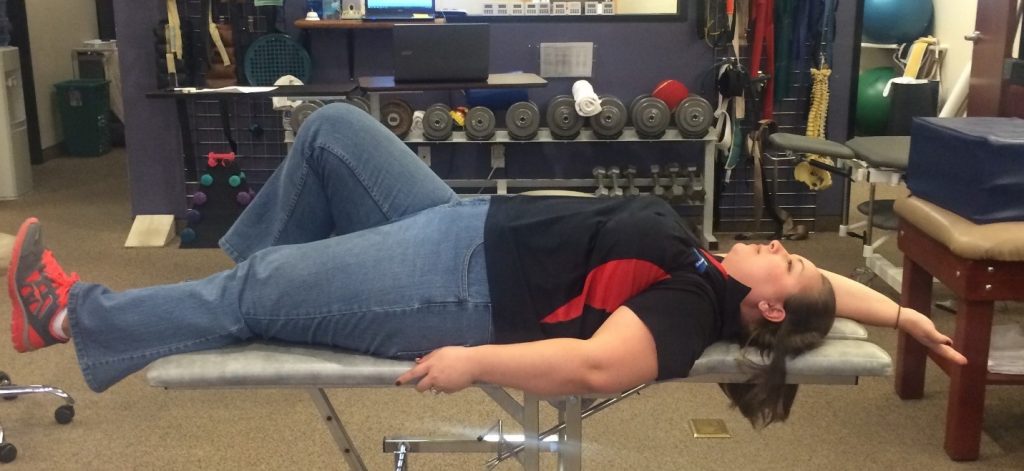
Lie on a table or floor in the position pictured above. Keep one knee bent at around a 90 degree angle. Reach to the far wall with the same side hand as the bent knee. Reach for the far wall below you with the opposite side’s heel.
Hold for 5 seconds then repeat on opposite sides.
Single knee to chest
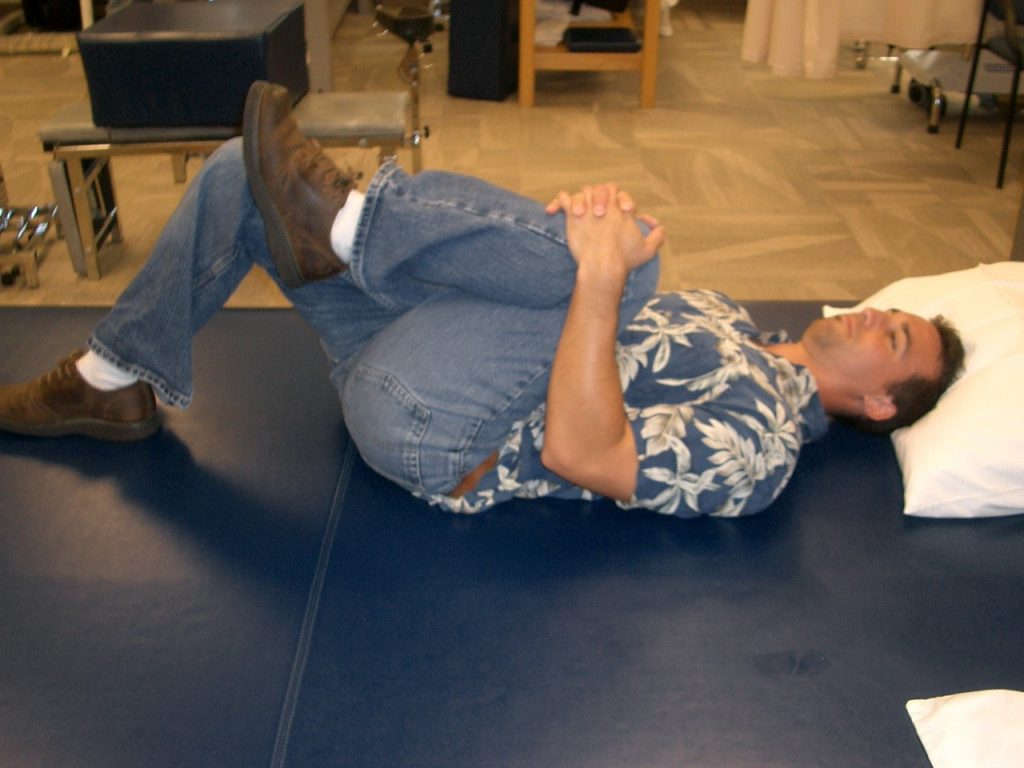
Keep your back pressed onto the floor or mat as pictured above. Using your hands, pull one knee up towards your chest. Hold this stretch for 30 seconds. Repeat on both sides for 10 repetitions.
Pelvic tilts
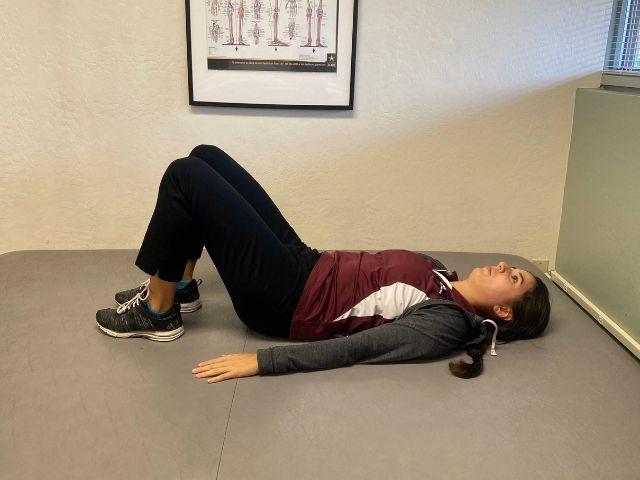
In this position, roll your hips back and press back onto the floor or mat as pictured below. Hold for 5 seconds then rest. Perform 10 repetitions.
Spinal stability
Dead bugs
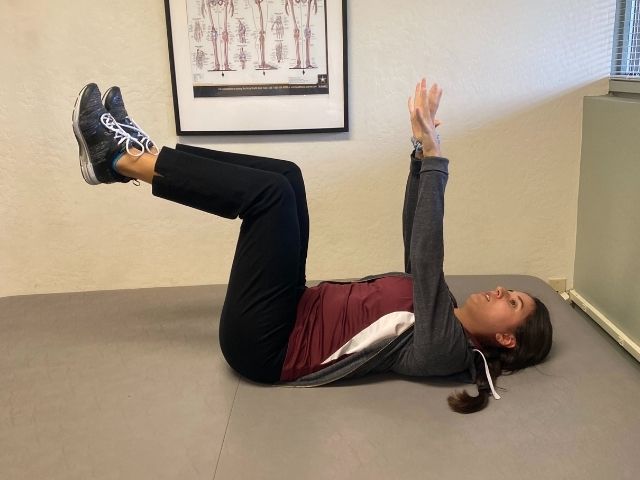
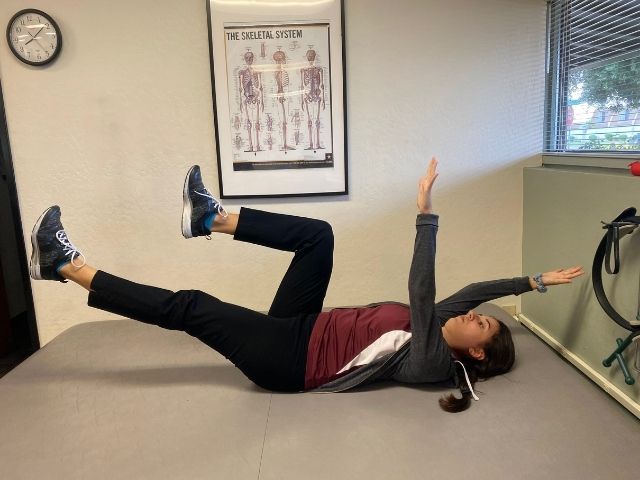
Lay on your back with your arms outstretched above your shoulders, and your knees up directly above your hips. Hold this position for 10 seconds with your back pressed into the floor or table. Slowly move one foot down towards the surface while simultaneously moving the opposite side hand outstretched above your head. Only move your extremities as far as you can while maintaining the position of your back pressed into the floor or table.
Hip Flexibility
Hip flexor stretch
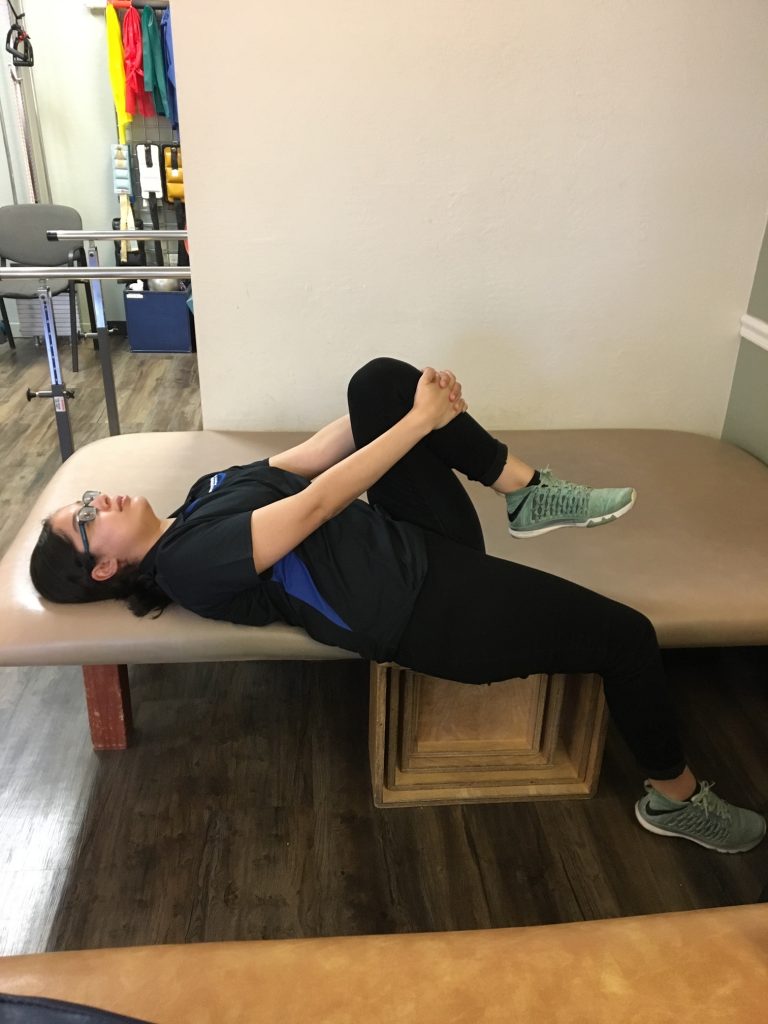
While there are many variations of hip flexor stretches that exist, this is one of our favorites. Use a bed or table for this exercise. Pull one leg up towards your chest using your hands, and allow the other leg to drop freely down to the floor.
Hold for 2 minutes per side. If you do not have access to a surface suitable for this stretch, simply look up some hip flexor stretches on Google – there are plenty of options.
Hamstring stretch
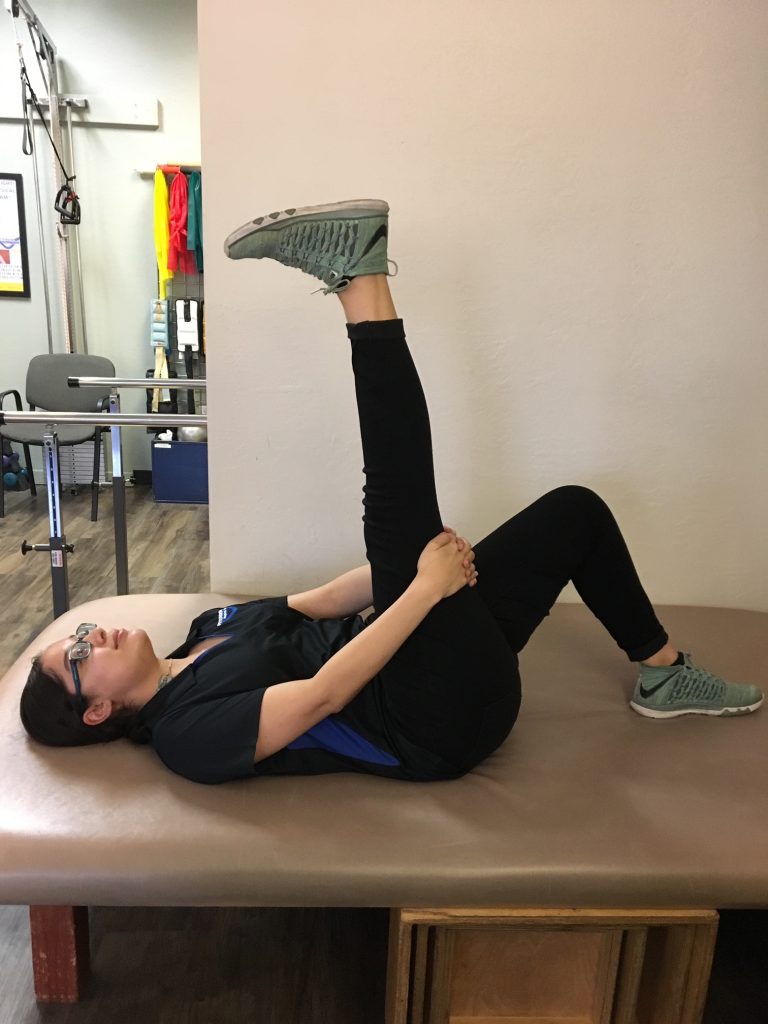
As with hip flexors, there are many variations of hamstring stretches that exist. Pictured above is one of our favorites. Lie on your back as pictured below. Hold for 2 minutes each side.
Gastrocnemius stretch
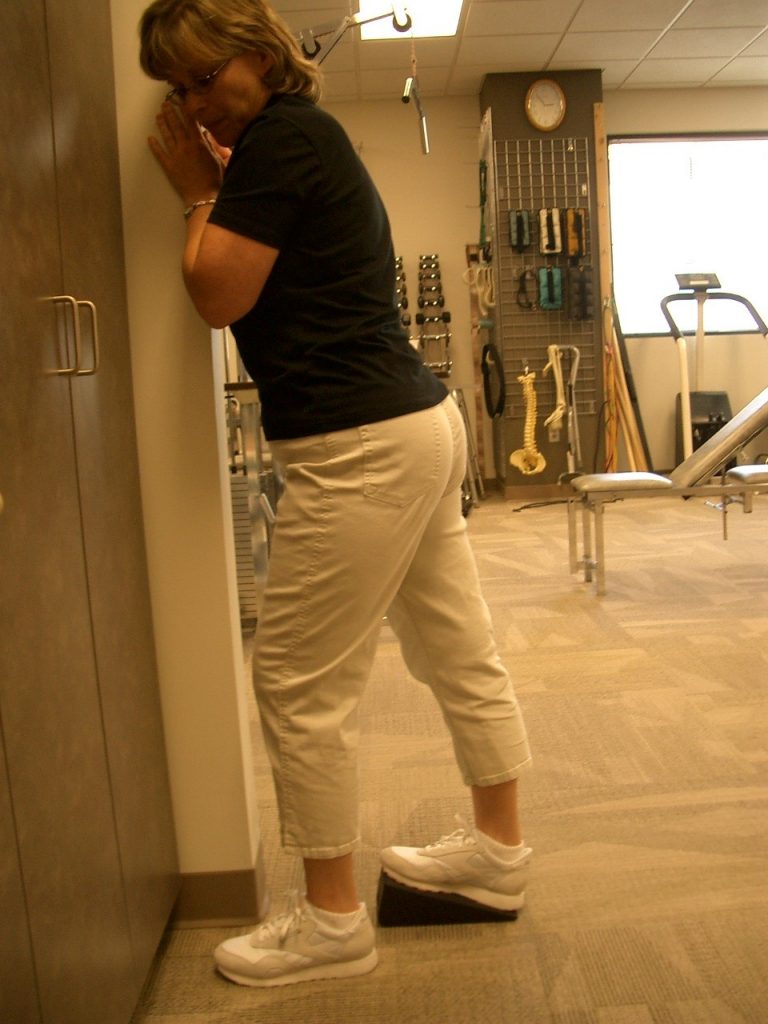
Use some sort of elevated surface (such as the wedge pictured above) to stretch the calves. If you don’t have a wedge, use a textbook, rolled towel, or a stack of magazines. Hold for 2 minutes each side.
Hip strength
Clams
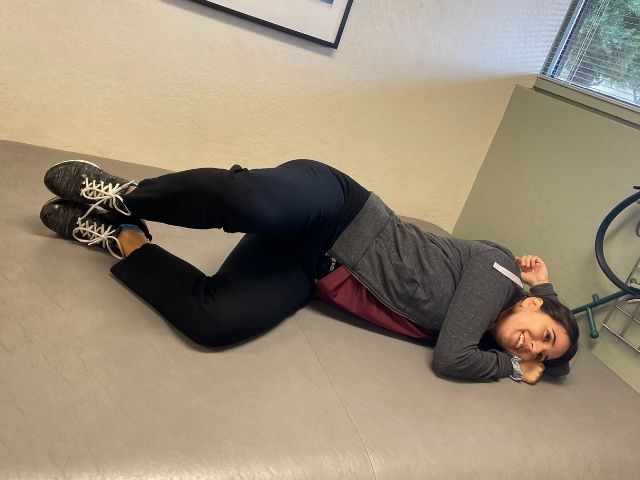
Lie on your side with knees bent and together. Lift your top knee away from your bottom knee while your feet stay together. Do not roll your hips back as you complete the movement.
Hold for a count of 2. Repeat 3 sets of 10 repetitions on each side.
Side lying hip abduction
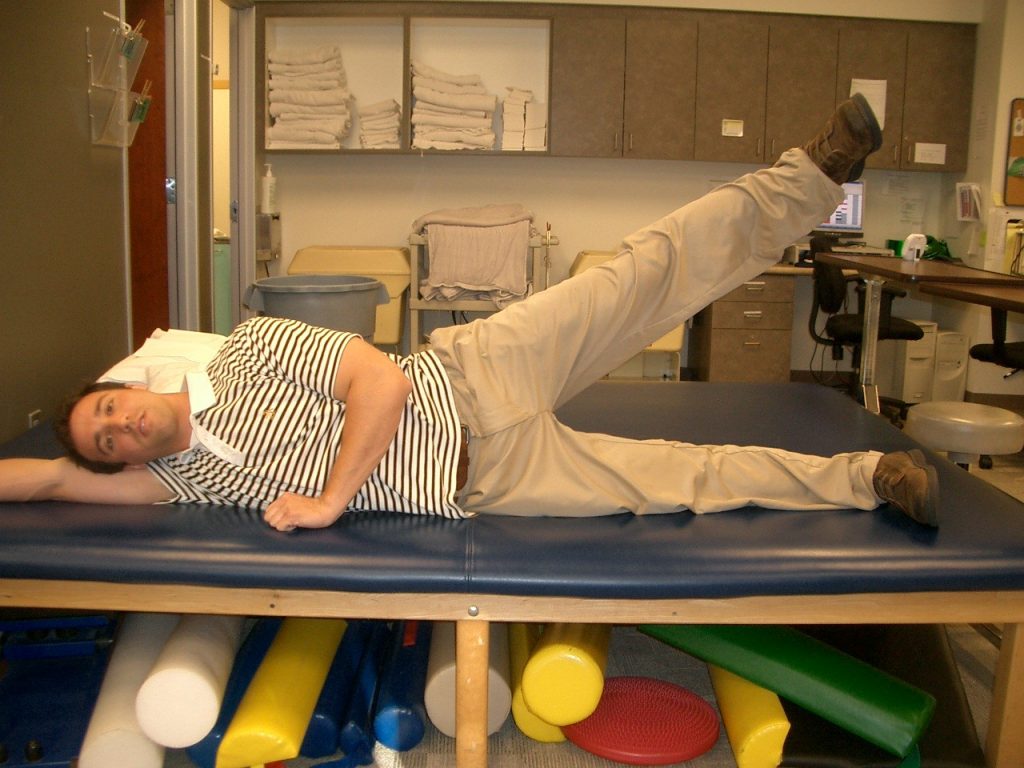
Lay on your side with legs together. While keeping your leg straight, raise your leg in the air leading with your heel. Make sure you do not move your hips or upper body.
Hold for 2 counts and repeat for two to three sets of 15 repetitions.
Stationary cycling
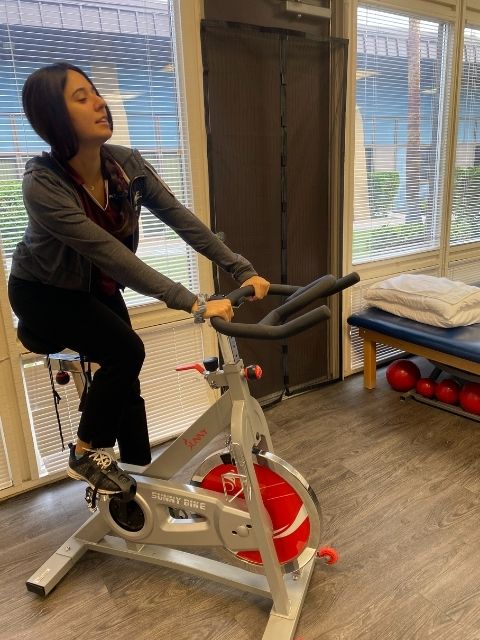
Start with 10 minutes and progress to 30 minutes over time. This exercise is also good for maintaining a healthy body weight.
Other treatments may include injections and in worse case scenarios surgery may be an option. In either case it is important to work on strength, flexibility and spinal stability. If you have questions feel free to contact us, see your Physical Therapist or medical provider.
What to do if your spinal stenosis doesn’t get better
As we’ve always encouraged, we urge you to seek medical advice from a spinal specialist. They will be able to educate you on treatment options after a physical exam and testing. Spinal stenosis causes unpleasant symptoms that often require the expertise of a specialist to solve.
If you live anywhere near the Phoenix East Valley area, contact us for a consultation and a referral to a good specialist if you need one. We’re also happy to complete your physical therapy treatment if you need it.

















